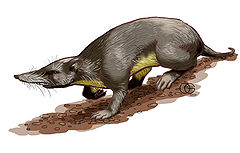- Nesophontes
-
Nesophontes[1] 
Nesophontes edithae Conservation status Scientific classification Kingdom: Animalia Phylum: Chordata Class: Mammalia Order: Soricomorpha Family: †Nesophontidae
Anthony, 1916Genus: †Nesophontes
Anthony, 1916Species †Nesophontes edithae
†Nesophontes hypomicrus
†Nesophontes longirostris
†Nesophontes major
†Nesophontes micrus
†Nesophontes paramicrus
†Nesophontes submicrus
†Nesophontes superstes
†Nesophontes zamicrusThe members of the genus Nesophontes, sometimes called West Indies shrews, were members of the extinct family of mammals Nesophontidae in the order Soricomorpha. This is the only genus described for this family. They were endemic to Cuba, Hispaniola (Dominican Republic and Haiti), Puerto Rico, the United States Virgin Islands, and the Cayman Islands. Although reliable estimates are unavailable, these animals are widely believed to have survived the Pleistocene extinction since remains have been found among those of Rattus and Mus species. Some authorities estimate extinction coinciding with the arrivals of rats (Rattus) aboard Spanish vessels in the early 16th century (1500). Others, such as Morgan and Woods, claim that some species survived until the early 20th century.[2] Their relations to the other West Indian soricomorphs, the solenodons, remain unclear.[3]
The West Indies shrews have only been described from fossil records and skeletal material in owl pellets found in the Greater Antilles and surrounding islands. Recent efforts to locate surviving populations have been unsuccessful.[4] Although some Nesophontes remains (in owl pellets) have been reported as fresh-appearing, radiocarbon dating has failed to support any post-15th century dates, suggesting that the nesophontids became extinct very rapidly at approximately the time of European discovery of the Greater Antilles.[5]
These animals were insectivores.
Since Nesophontes species have only been observed through fossil records the exact number of species varies among authorities. Some claim as many as 12 valid species while other claim as few as six.[1]
- Puerto Rican Nesophontes (Nesophontes edithae)
- Atalaye Nesophontes (Nesophontes hypomicrus)
- Slender Cuban Nesophontes (Nesophontes longirostris)
- Greater Cuban Nesophontes (Nesophontes major )
- Western Cuban Nesophontes (Nesophontes micrus)
- St. Michel Nesophontes (Nesophontes paramicrus)
- Lesser Cuban Nesophontes (Nesophontes submicrus)
- Cuban Nesophontes (Nesophontes superstes)
- Haitian Nesophontes (Nesophontes zamicrus)
Two other species from the Cayman Islands remain undescribed.[6]
See also
References
- ^ a b Hutterer, Rainer (16 November 2005). "Order Soricomorpha (pp. 220-311)". In Wilson, Don E., and Reeder, DeeAnn M., eds. Mammal Species of the World: A Taxonomic and Geographic Reference (3rd ed.). Baltimore: Johns Hopkins University Press, 2 vols. (2142 pp.). pp. 220–222. ISBN 978-0-8018-8221-0. OCLC 62265494. http://www.bucknell.edu/msw3/browse.asp?id=13700003.
- ^ Morgan, G. S., and C. A. Woods (1986). "Extinction and the zoogeography of West Indian land mammals". Biological Journal of the Linnean Society 28: 167–203. doi:10.1111/j.1095-8312.1986.tb01753.x.
- ^ Whidden, H. P.; Asher, R. J. (2001). "The origin of the Greater Antillean insectivorans". In Woods, C. A.; Sergile, F. E.. Biogeography of the West Indies: Patterns and Perspectives. Boca Raton, London, New York, and Washington, D.C.: CRC Press. pp. 237–252. ISBN 0-8493-2001-1. http://books.google.com/books?hl=en&lr=&id=kDchYICxSDsC&oi=fnd&pg=PA237&dq=The+origin+of+the+Greater+Antillean+insectivorans&ots=nE1h2qsklP&sig=-7Df5woZLVJoe3JFs_AqsH4XLyU#v=onepage&q=The%20origin%20of%20the%20Greater%20Antillean%20insectivorans.
- ^ Woods, C. A., J. A. Ottenwalder, and W. L. R. Oliver (1985). "Lost mammals of the Greater Antilles: summarized findings of a ten week field survey in the Dominican Republic, Haiti and Puerto Rico". Dodo (Jersey Wildlife Preservation Trust) 22: 23–42.
- ^ MacPhee, R. D. E., C. Flemming, D. P. Lunde (1999). ""Last occurrence" of the Antillean insectivoran Nesophontes : new radiometric dates and their interpretation". American Museum of Natural History "Novitates" (3261). http://hdl.handle.net/2246/3106.
- ^ Morgan, G.S. 1994. Late Quaternary fossil vertebrates from the Cayman Islands. Pp. 465–508 in Brunt, M.A. and Davies, J.E. (eds.). The Cayman Islands: Natural History and Biogeography. Springer, 604 pp. ISBN 9780792324621
External links
Categories:- Nesophontes
- Extinct animals of the Caribbean
- Extinct mammals
Wikimedia Foundation. 2010.
